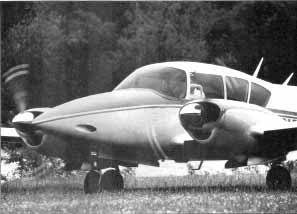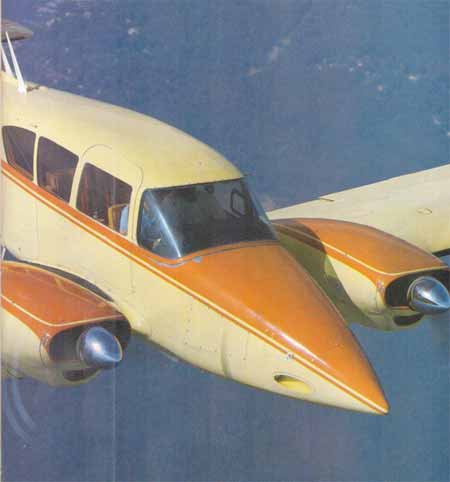The Apache
Indian was a strong, fiercely independent fighting
machine — short of stature, long of heart. The flying machine,
which stole this proud name, could lay claim to only that . . . the
name. Actually there have been at least two airplanes named Apache
(plus the current military helicopter): The first, by North American
was the A-36, the precursor to the mighty Mustang and the name fit
nicely. The second, by Piper, and the name definitely did not fit.
The Piper Apache, originally a Stinson design with a twin-tail, was
the first practical light twin. Introduced in 1954, the little
airplane used a couple of 150 hp 0-320 Lycomings and established
new meanings for the word "marginal" when it came to engine-out
performance. That judgement's not entirely fair, since it is only in
hindsight that the Piper Apache has earned the title as the sweet potato
of the light twin set. It wasn't until there were other, more successful,
light twins (aka, the C-310) that the Apache was shown to be woefully
under-everythinged. The only other small twin available when the Apache
debuted was the surplus UC-78/T-50 Bamboo Bomber and, compared to those,
the Apache was a space shuttle.
As much maligned as the old PA-23 is, several generations of aspiring
multi-engine pilots who earned their ratings in the bird before it
was replaced by the likes of the Seneca. As a trainer, the Apache couldn't
be beat. The small engines only burned 7-8 gallons a side and, as they
were progressively upgraded with 1/2-inch valves, were basically bullet
proof. Considering the beating the airframes took in training,
the same could be said for the airplanes in general. More important
than all the foregoing is the airplane's gentle soul. Docile is too
harsh a word to be used in describing the Apache's overall character.
The Apache is an incredibly easy airplane to fly and has to be pushed
hard for it to do anything stupid on one engine. If an engine quits,
most of the decisions are already made since the airplane will barely
stay in the air on one. But, at that point, the airplane is totally
under control and gives the pilot all day to get it cleaned up and
figure out which engine was gone
The stories of Apaches gyrating out of control when an engine
quit on takeoff are few and far between. The Apache would just come
down somewhere they weren't supposed to in the gentlest of crashes.
Contrast that with the C-310 — its closest contemporary. In that
bullet, the pilot has to actually know what he is doing to save the
plane should an engine decide to pack up when low and slow.
Another point overlooked about the old Apache is that it is comfortable
and huge inside. The Apache is actually larger than a late model Baron.
Also, the Piper handles quite nicely with controlls, which
are always working, even below stall speed. In short, it is a pretty
good old airplane seriously in need of a little tweaking
and a lot of horsepower. Enter the modifiers.
The airplane went out of production in 1960 with the "G" model,
by which time it had picked up a third window and ten more horses a
side. Big deal! A few years later, once the price of the used Apaches
started down, a whole slew of conversions came along. These ranged
from doing nothing more than hanging on 170 hp Lycomings
(0-340s of helicopter lineage), to fire breathing, total airframe mods
with engines as big as 220 hp Franklins. Names like Miller, Doyn and
Nyak are well known, but possibly the most successful is the Geronimo
conversion by Seguin Aviation in Seguin, Texas.
Seguin tackles the project from two approaches: First they redesigned
parts of the airframe to give it better aerodynamics, then they take
advantage of the aerodynamics with more horsepower. In actuality, this
happens simultaneously at their plant, but it is still possible to
get a complete Geronimo airframe but still have the 160 hp engines.
Only a very few buyers take that route — most opt for the 180
hp 0-360 version because of the tremendous performance gains.
When the airframe shows up at the Seguin plant, either under its own
steam or on a flat bed, it is completely disassembled. As in completely!
Seguin's objective is to remanufacture the airframe to near-new standards.
They can't totally eliminate the "used" portions of the airframe,
but they can replace those parts that show the most wear and fatigue.
When Seguin supplies the airplane for the conversion, it is one they've
selected because of total time and condition. The company will do the
same process on a customer's airplane.
 |
The mods greatly improve the airplane's looks. This airplane
doesn't have the Geronimo cowls. |
Seguin then starts doing their
Geronimo war dance on the airplane. The first mod is to replace the
Apache's characteristic blunt nose with a 31-inch longer, gracefully
pointed unit incorporating landing lights and a baggage compartment.
The air is easily forced aside by the nose and continues flowing
over the new one-piece windshield to an enlarged and squared-off
vertical tail unit that does a lot to lower the airplane's Vmc. Even
if the nose and tail didn't do anything for performance — which they do (7 mph according to factory literature) — they
so dramatically improve the airplane's appearance, they are worth it
for that reason alone. Gone is the sweet potato countenance.
One of the major drag areas on Apaches is the semi-retractable landing
gear. Yes the gear retracts but it leaves almost half of all three
wheels hanging out in the wind and the wheel wells are open, letting
tremendous amounts of air circulate, generating equally tremendous
amounts of drag. So much of the wheels extend, it almost looks as if
an Apache could taxi on them if it had short enough props. Seguin installs
full coverage doors that not only streamline the wheels, but seal the
gear wells, too. This mod is good for 12 mph, which isn't surprising.
One of the latest Seguin mods is a new fiberglass cowl that adds a
little speed, but is done primarily to make it easier to get at the
engines. They now can completely uncover an engine in under two minutes.
The wings get Hoerner shaped tip extensions that not only help in the
speed department (4 mph), but do wonders for the stall speed. Lots
of other little goodies like wing root fairings, cowl fairings, a new
tail cone and other do-dads here and there contribute to a much lower
drag coefficient for the airframe.
The inside of the airplane is totally gutted and everything from the
nose cone back is replaced. Starting at the front, the instrument
panel, already fairly commodious but rather haphazard, is replaced
by a broad expanse of flat black that allows the development
of an instrument layout, which will make a 747 jealous. The panel is
both higher and wider, although a little square looking, has to be
one of the largest panels available in any airplane that size.
The five-seat interior design is usually designed especially for the
customer, who has options of adding a sixth seat. The changes include
new window frames, control wheels, Aztec type windows, extended rear
baggage compartment, extra sound proofing and a tight fitting door
seal.
Of course, the serious performance boost comes out of swapping in a
pair of 0-360A1A 180 hp engines. This 20 percent increase in power,
combined with the drag reduction program on the airframe, does wonderful
things in both cruise and takeoff. Seguin's aim was to produce an airplane
that held on to the Apache's gentle nature but with much improved performance
in all areas, including takeoff/landing, cruise and single-engine capabilities.
This they have done.
GO
TO NEXT PAGE
|



